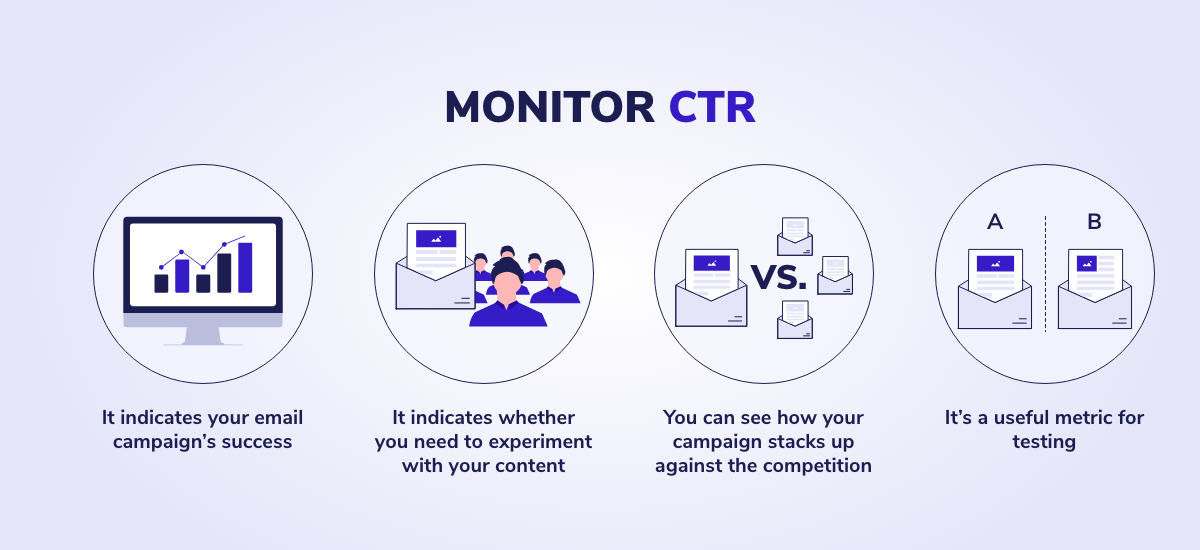What is click-through rate?
Courses: Inbox
Create: 1741 days ago
Update: 1613 days ago
Reading time: 4 min
You can use many metrics to measure your email campaign’s success, but the click-through rate is one of the most important. It’s a benchmark of how many people are engaging with your email and interested in knowing more. If a user feels compelled to click on your content, it’s usually a good indicator they want to learn about your brand and what you have to offer.
In this lesson, you’ll learn:
- What click-through rate (CTR) is
- How CTR is calculated
- Why it is crucial to monitor CTR
What is click-through rate?
Click-through rate is the percentage of how many people clicked on at least one link within your email. (A “link” can include any hyperlinked images or calls-to-action contained within the email, as well.) It’s one of the most critical benchmarks of any email’s performance and one of the most commonly monitored day-to-day metrics. Understanding your email’s click-through rate is essential to measuring your campaign’s success. But first, it’s also a good idea to have a clear understanding of what a “click” is within the context of an email campaign.
What are total clicks vs. unique clicks?

- Total clicks: The total of all clicks within your email campaign (i.e., every single time users clicked a link)
- Unique clicks: The total number of times a link was clicked on for the first time (i.e., every time a user clicked a link for the very first time).
Example: A user clicks on 5 different links in your email. These are 5 total clicks and 5 unique clicks. Another user only clicks on one link but clicks on it 3 times. This counts as one unique click and 3 total clicks.
How is the click-through rate calculated?

Click-through rate is calculated by taking the total number of clicks (or unique clicks) an email received and dividing it by the total number of delivered emails. This formula will give you a percentage, or rate, of how many people clicked on a link in your email in relation to its overall delivery rate.
Here’s a quick and easy way to calculate an email’s CTR:
(Total clicks or unique clicks ÷ number of delivered emails) * 100
Let’s take a look at this example:
300 clicks ÷ 5,000 delivered emails * 100 = 6% click-through rate
Why is it important to monitor CTR?

There are several reasons why it’s essential to measure CTR:
- It indicates your email campaign’s success on a daily basis and over time: CTR is an incredibly valuable metric for measuring your email campaign’s success frequently. It’s a metric you can measure for each email individually, every time you send it. Once you start accumulating data, you can see how an email campaign is performing over time.
- It indicates whether you need to experiment with your content, offers, or CTAs: CTR directly shows how many of your email recipients actively engage with the content in your email. While open rate shows whether users are interested enough to open your email, click-through rate indicates whether they want to interact with its content. This can help you determine whether your copy, design, imagery, offers, and CTAs (calls to action) are actually grabbing – and keeping – your users’ attention.
- You can see how your campaign stacks up against the competition: CTR is also known as “benchmark data,” which can help you compare your campaign’s performance against standards in your industry.
- It’s a useful metric for testing: Testing different versions of emails with different audiences, also known as A/B testing, is a great way to determine which elements of an email affect its performance. For example, you might send Audience A an email with an illustration of your product and Audience B an email with a photo of your product. You can now determine which email receives a higher CTR and use these findings to improve the content of future emails or perform other tests.
Now that you understand the basics of click-through rate, you know how
important it is to measure your email campaign’s success
 Why is click-through rate important?
Click-through rate (CTR) is one of the most important metrics in measuring your email campaign's success.
Read more »
. But it’s not the only metric that matters. On EmailAcademy, you can learn more about how you can optimize your email campaigns and drive better results.
Why is click-through rate important?
Click-through rate (CTR) is one of the most important metrics in measuring your email campaign's success.
Read more »
. But it’s not the only metric that matters. On EmailAcademy, you can learn more about how you can optimize your email campaigns and drive better results.



